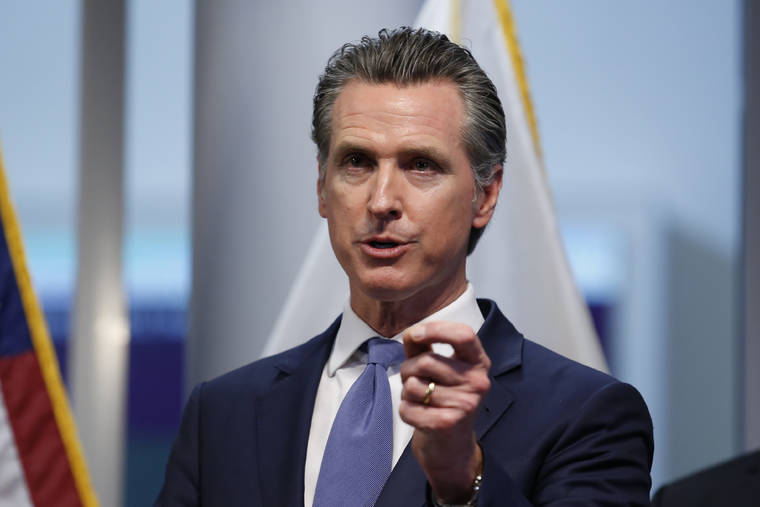SACRAMENTO, Calif. — Gov. Gavin Newsom’s assessment that it’s likely “few if any” California schools will reopen before summer break surprised parents, who wondered Wednesday how distance learning would work.
David De Leon, whose son is an 8th-grader in Santa Ana, said he was shocked by the announcement.
“I don’t know if it’s viable,” De Leon said. “To throw it out for everyone to use until the end of the school year I think is unreasonable.”
Before his son’s school shut down, he was told to take all his schoolbooks and school-assigned Chromebook home. For now, teachers are suggesting that kids use certain academic programs until they can develop a distance learning curriculum, he said.
In Los Angeles, Filiberto Gonzalez, 45, said his three children have been in touch daily with their teachers and have an hour to four hours per day of work they can do on an existing online platform that supplemented classes. But the prospect of moving to an entirely online system raises a slew of challenges few were expecting.
“This whole process started with OK, we’re going to be away from school for two weeks, take this material with you, here’s a Chromebook,” he said. “The news that came yesterday was a real shock to a lot of us.”
Some parents are making their children get up at the same hour as if they are in school and have a scheduled day of online learning. Others are taking advantage of the online resources provided by school districts, like “Skype with a scientist” offered by the San Diego Unified School District, and virtual tours through museums worldwide.
San Diego high school teacher Elena Lujan-Alba said her 10th grade daughter is missing out on testing for Advanced Placement classes. But Lujan-Alba, whose husband is a math consultant for schools, is not as worried about keeping their two daughters up with academics as much as she is about their social activities.
“We try to manage the kids’ expectations. I tell them, ‘Guys you know that probably won’t happen,’ to prepare them mentally. Then it’s like OK, that’s not happening. It’s like stages of grief, of letting go,” Lujan-Alba said.
The Los Angeles Unified School District, which normally serves a million meals a day to students in the nation’s second-largest school district, on Wednesday debuted 60 “grab and go” stations to distribute breakfasts and lunches — a major scale-down from initial plans for family resource centers offering childcare and other services.
Newsom said Tuesday that nearly 99% of the state’s K-12 schools are shuttered for periods generally ranging from two to five weeks.
“It is unlikely that many of these schools, few if any, will open before the summer break,” he said, urging the more than 6 million schoolchildren and their families to make long-term plans.
The California Department of Public Health said Wednesday the state now has 13 deaths related to the coronavirus and 598 confirmed cases. More than 11,900 people are self-monitoring after returning from overseas.
While urging Californians to stay united and promising “we will get back to the life that we have lived,” Newsom also acknowledged that much is unknown and so the state is preparing for frightening worst-case scenarios.
The California National Guard is on alert for potential duties that include humanitarian missions like ensuring proper food distribution and public safety as some grocery stores resorted to rationing to control panic buying.
Ten Northern California counties and the Southern California city of Palm Springs have told residents to shelter in place, limiting movement to only essential purposes, and other jurisdictions have issued similar recommendations.
Newsom has encouraged all people 65 and older and those with underlying health conditions to stay indoors. He’s also called for the shutdown of bars, movie theaters, fitness centers and other gathering places, and for restaurants to only serve to-go orders.
Some counties have issued legally binding orders on specific types of businesses.
For areas not sheltering in place, state and national parks remained an alternative to sitting on the couch, but with limitations.
California State Parks announced it is temporarily closing all its campgrounds, but trails and beaches would remain open, along with restrooms. Visitors were reminded to maintain social distancing. The department last week suspended guided tours and large events and closed visitor centers and museums.
Those who can’t make it outside have an online alternative to enjoy California’s coming spring.
In the tiny desert town of Borrego Springs, which draws throngs of tourists when rains bring a “super bloom” of wildflowers, residents are making videos and photographs of the evolving landscape and posting them on a web page called ” Borrego Outside For People Inside.”
“We hope it brings people a little bit of diversion, of happiness, a feeling of actually being here,” said Mike McElhatton, program director of the Anza-Borrego Desert Natural History Association.
———
Associated Press journalists Amy Taxin in Santa Ana, Julie Watson in San Diego, John Antczak in Los Angeles, John Rogers in La Habra Heights and Kathleen Ronayne, Cuneyt Dil and Don Thompson in Sacramento contributed to this story.





